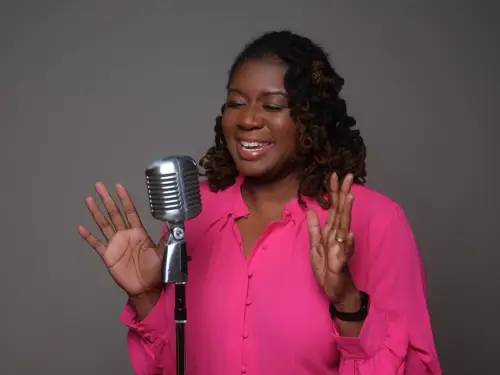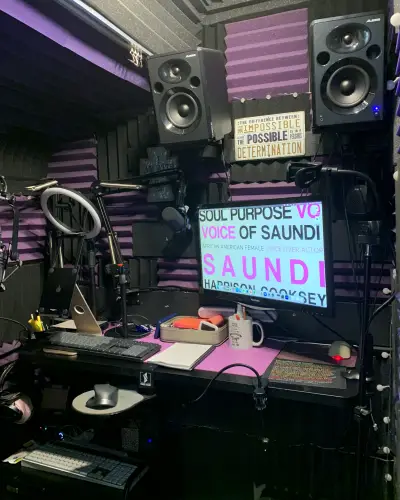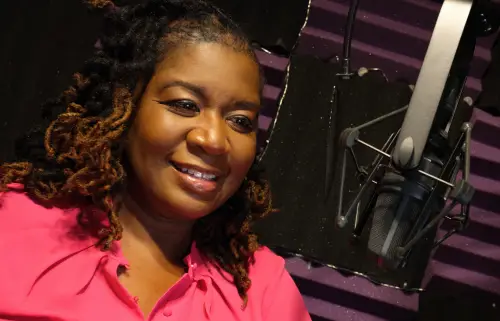 One of the newest additions to our Voice Talent roster is Saundi. As one of the editors at Marketing Messages, I often have the opportunity to work with her recordings. There’s a lot I like about Saundi’s audio. The sound quality is impeccable. But I also love the sincerity in her recordings and her commitment to conveying the meaning of every line of every script.
One of the newest additions to our Voice Talent roster is Saundi. As one of the editors at Marketing Messages, I often have the opportunity to work with her recordings. There’s a lot I like about Saundi’s audio. The sound quality is impeccable. But I also love the sincerity in her recordings and her commitment to conveying the meaning of every line of every script.
In an effort to shine a spotlight on African American Voice Talent Saundi, and provide our customers with an opportunity to listen to her and get to know her, I invited Saundi to participate in a Voice Talent Spotlight. Here are her thoughtful responses:
Tell me about your prep work before you actually record. And then your mindset while you’re recording, say for Signature Healthcare.
Thank you so much for the kind words! My prep process is something I’ve refined over time, and it really centers around what I call my “3 M’s”: meditation, movement, and music. As voiceover is a full-time profession for me, I start my day with a consistent routine that helps me get into the right mindset. Meditation allows me to clear my head and focus on the day ahead. Movement—whether it’s a walk, yoga, or some light stretching—helps to wake up my body. And music sets the tone and energy for the day.
After my morning routine, I do some vocal warmups. I’m a big fan of tongue twisters and mouth exercises, and I typically do these in the shower. The steam helps to open up my lungs and warm up my vocal cords, plus it’s a fun way to get started. I usually sing a bit—it might sound silly, but it’s become an essential part of my process. This routine helps me maintain a sense of discipline and readiness, which I think is crucial when you’re in this line of work.
When I step into the booth to record, especially for a client like Signature Healthcare, my focus is on connection. I remind myself how grateful I am to do this work and how important it is to convey the meaning behind every word. I want each line to resonate with the listener, so I make sure that when I play it back, it convinces me first. I’m always striving to deliver my best, not just technically but emotionally, ensuring that my voice truly serves the client’s needs.
 Your custom studio space is truly awesome. What is the evolution of your studio compared to when you first started voiceover work?
Your custom studio space is truly awesome. What is the evolution of your studio compared to when you first started voiceover work?
Thank you! The evolution of my studio has been an interesting journey over the past four years. When I first started, my “studio” was actually a linen closet on the downstairs level of our home. It was a tiny space—just enough room to squeeze in a mic, mic stand, and an iPad stand, with me wedged in there too. The closet was positioned between a bathroom and a laundry room and had a high ceiling, which wasn’t exactly ideal for soundproofing. But my husband got creative and cut a large cardboard box with a hole in the middle to feed my mic through, which helped to insulate the sound and reduce that boxy echo. It was a very innovative, budget-friendly solution, and it worked surprisingly well for about two years.
During that time, I would do auditions daily in this small space, either before or after my full-time job. I even managed to book a few jobs from those closet recordings! Eventually, I moved upstairs to a bedroom that had a small alcove, and it was like the universe had aligned to give me that perfect spot. I set up in that alcove with the same cardboard box setup, now enhanced with some acoustic foam and heavy sound blankets, and that worked up until 2020.
When the pandemic hit and the VO industry saw a boom, I realized it was time to upgrade. My husband, who had always been supportive, took it a step further and built me a custom studio. He used the alcove as three walls and added a fourth wall with a solid core wood door. What started in a linen closet evolved into a fully customized studio over about four years. Honestly, if it weren’t for the pandemic, I probably would have invested in a WhisperRoom or Studiobricks, but now I wouldn’t trade my custom booth for anything—it’s a reflection of the journey and growth in my career.
Most Voice Talents don’t have two different microphones – both wired and ready for action – in their booth. But you do. Why two microphones?
There are definitely a few schools of thought when it comes to having multiple microphones in your booth, and for me, it boils down to versatility, preference, and, I’ll admit, a bit of a love for gear! Each microphone has its own unique qualities that can really bring out different aspects of your voice, depending on the project. In my case, I have a large diaphragm mic and a shotgun mic, and each serves a distinct purpose.
The large diaphragm mic, a Neumann TLM 103, s versatile and works well across a broad range of genres—whether it’s commercial, narration, or eLearning. It captures the warmth and nuances of my voice, making it ideal for most of my work. On the other hand, the shotgun mic, Shure SM7B, is directional microphone and is designed to capture sound from a specific direction while rejecting noise from other directions. So they are often used in noisy environments and are a good choice genres like promos, trailers, or video game work
Having two mic set up and ready to go means quickly switching between them depending on the project genre or Audio Engineer requests. Some clients have a specific sound in mind, and being able to offer that flexibility without losing any time is a real advantage. I also think VO actors have two mics due to a growth and progression in their VO career—many of us start with one reliable mic and, as we grow and diversify, we make an upgrade in gear. I use my TLM 103 about 98% of the time, but it’s comforting to know my Shure SM7B is there if I need it. Plus, having both gives me options, and in this industry, that can be crucial.
 As an African American female Voice Talent, how conscious are you of the responsibility to relate to and even reflect the audience that you’re serving? It seems particularly important for a healthcare client like Signature Healthcare.
As an African American female Voice Talent, how conscious are you of the responsibility to relate to and even reflect the audience that you’re serving? It seems particularly important for a healthcare client like Signature Healthcare.
I’m so glad you asked this question because it touches on something I’m deeply passionate about. As an African American female Voice Talent, I’m acutely aware of the responsibility I have to connect with and reflect the audience I’m serving. It’s not just about reading a script—it’s about authentically conveying the message in a way that resonates with the target audience.
For me, this process begins long before I step into the booth. I take the time to research the client, the product, and the intended audience. I want to understand who I’m speaking to, what their needs and concerns might be, and how my voice can bridge that gap. It’s about making sure that the voice they hear on the other end truly represents them and speaks to their experience.
This is especially important in healthcare, where trust and empathy are crucial. When I’m recording for a client like Signature Healthcare, I’m not just reading lines—I’m thinking about the patients, the healthcare providers, and the families who will be listening. I aim to bring sincerity and warmth to my performance because I know that the voice they hear can make a significant impact on their experience.
In live directed sessions, I make it a point to ask questions about the audience if I haven’t been able to gather enough information beforehand. Understanding the audience helps me to deliver a performance that is not only authentic but also deeply connected to the people it’s meant to serve. It’s a responsibility I take seriously because I believe that every voiceover should be a bridge between the client’s message and the audience’s needs.
Connect with Us about the Possibility of Using Saundi for Your Next Project
Ready to talk to us about working with African American Voice Talent Saundi for your next Messages-On-Hold, Auto Attendant, or IVR prompts? Take the steps NOW to expand and diversify your options for the next time you need professional voice recordings.
